COMBINING TRANSFORMATIONS WITH DILATIONS
When creating an animation, figures need to be translated, reflected, rotated, and sometimes dilated. In this section, we are going to see, how different types of transformations can be combined with dilations.
Example :
A rectangle has the vertices (-6, 8), (-2, 8), (-2, 6) and (-6, 6). Apply the indicated series of transformations to the triangle. Each transformation is applied to the image of the previous transformation, not the original figure. Label each image with the steps of the transformation applied.
(i) (x, y) → (x + 7, y - 2)
(ii) Reflection across the x-axis.
(iii) Clockwise rotation of 90° around the origin
(iv) (x, y) → (x + 5, y + 3)
(v) Dilation about the origin with scale factor 3.
Compare the size and shape of the final image to that of the original figure.
Solution :
Step 1 :
(i) (x, y) → (x + 7, y - 2).
(-6, 8) -----> (1, 6)
(-2, 8) -----> (5, 6)
(-2, 6) -----> (5, 4)
(-6, 6) -----> (1, 4)
Graph the image.
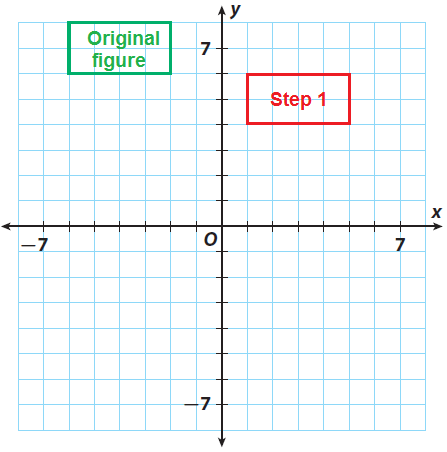
Step 2 :
(ii) Reflection across the x-axis.
Since there is a reflection across the x-axis, we have to multiply each y-coordinate by -1. That is,
(x, y) -----> (x, -y)
So, we have
(1, 6) -----> (1, -6)
(5, 6) -----> (5, -6)
(5, 4) -----> (5, -4)
(1, 4) -----> (1, -4)
Graph the image.
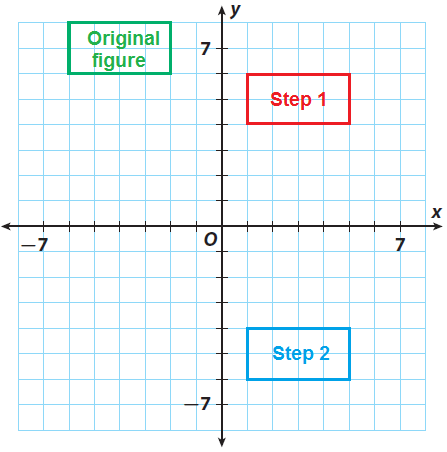
Step 3 :
(iii) Clockwise rotation of 90° around the origin.
Since there is a rotation of 90° clockwise about the origin, we have multiply each x-coordinate by -1 and interchange x and y coordinates. That is,
(x, y) -----> (y, -x)
So, we have
(1, -6) -----> (-6, -1)
(5, -6) -----> (-6, -5)
(5, -4) -----> (-4, -5)
(1, -4) -----> (-4, -1)
Graph the image.
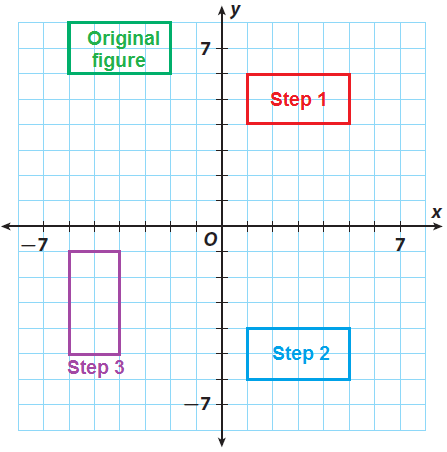
Step 4 :
(iii) (x, y) → (x + 5, y + 3)
(-6, -1) -----> (-1, 2)
(-6, -5) -----> (-1, -2)
(-4, -5) -----> (1, -2)
(-4, -1) -----> (1, 2)
Graph the image.
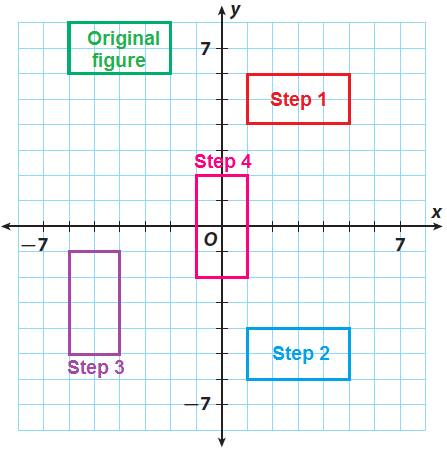
Step 5 :
(iii) (x, y) → (3x, 3y)
(-1, 2) -----> (-3, 6)
(-1, -2) -----> (-3, -6)
(1, -2) -----> (3, -6)
(1, 2) -----> (3, 6)
Graph the image.
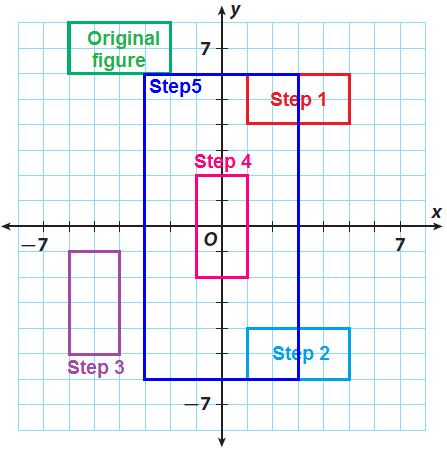
Compare the size and shape of the final image to that of the original figure.
Shape :
Same shape
Size :
The sides of rectangle E are three times the lengths of the sides of the original figure.
Angle Measures :
Same angle measures
Reflect
1. Which transformation represents the dilation? How can you tell?
(x, y) → (3x, 3y) ;
The algebraic form of a dilation is
(x, y) → (kx, ky)
In this case, k = 3.
2. A sequence of transformations containing a single dilation is applied to a figure. Are the original figure and its final image congruent? Explain.
No
The dilation would shrink or expand the figure so that it and its final image would not be the same size.
Kindly mail your feedback to v4formath@gmail.com
We always appreciate your feedback.
©All rights reserved. onlinemath4all.com
Recent Articles
-
Trigonometry Reciprocal Identities
Apr 28, 24 10:10 AM
Trigonometry Reciprocal Identities -
IB Diploma Mathematics Problems on Exponents
Apr 28, 24 05:42 AM
IB Diploma Mathematics - Problems on Exponents -
Finding Vertex of a Quadratic Function Worksheet
Apr 27, 24 11:06 AM
Finding Vertex of a Quadratic Function Worksheet
